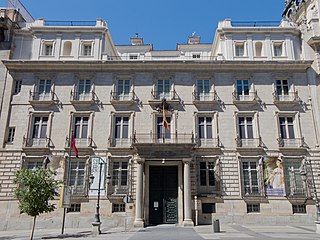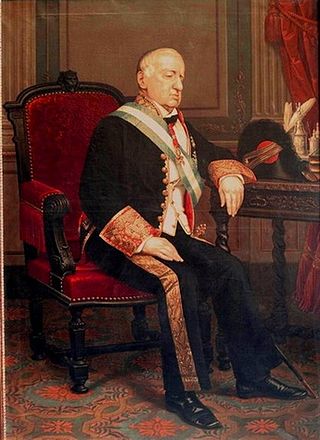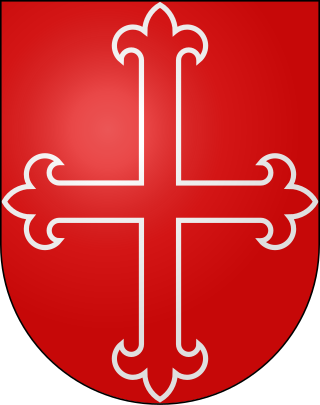Contents
| |||||
| Decades: | |||||
|---|---|---|---|---|---|
| See also: | Other events of 1996 List of years in Spain | ||||
Events in the year 1996 in Spain
| |||||
| Decades: | |||||
|---|---|---|---|---|---|
| See also: | Other events of 1996 List of years in Spain | ||||
Events in the year 1996 in Spain

Juan Yagüe y Blanco, 1st Marquis of San Leonardo de Yagüe was a Spanish military officer during the Spanish Civil War, one of the most important in the Nationalist side. He became known as the "Butcher of Badajoz" because he ordered thousands killed, including wounded Republican soldiers in the hospital.

José García de León y Pizarro was Minister of State of Spain from 30 October 1816 to 14 September 1818. He married Maria Mercedes Avila and had a son Rafael Garcia. He was a member of the Senate as a Hero of the Kingdom from 1834 to 1835. Prior to this, he briefly emigrated and settled in France from 1823 to 1830 after he was exiled.

The Real Academia de Bellas Artes de San Fernando, located on the Calle de Alcalá in the centre of Madrid, currently functions as a museum and gallery. A public law corporation, it is integrated together with other Spanish royal academies in the Instituto de España.

The Royal Academy of History is a Spanish institution in Madrid that studies history "ancient and modern, political, civil, ecclesiastical, military, scientific, of letters and arts, that is to say, the different branches of life, of civilisation, and of the culture of the Spanish people". Spanish people in this regard are understood to be citizens of the Kingdom of Spain or the indigenous people of its predecessors, or their descendants. The academy was established by royal decree of Philip V of Spain on 18 April 1738. Its official publication is the Boletín de la Real Academia de la Historia.

José María Álvarez Mendizábal was a Spanish politician and lawyer.

José Martín de Aldehuela was a Spanish architect, born in Manzanera, in Teruel Province, Aragon.

Joaquín María de Ferrer y Cafranga was a Spanish politician and military who served as Prime Minister of Spain in 1841, and held other important offices such as Minister of State, Mayor of Madrid and President of the Senate. He also served as Deputy Prime Minister between 1840 and 1841. He also served as a Deputy for Guipúzcoa from 1822 to 1837.
Juan José Mantecón was a Spanish composer. He was a member of Generation of '27 and the Group of Eight, the latter of which also included composers Jesús Bal y Gay, Ernesto Halffter and his brother Rodolfo, Julián Bautista, Fernando Remacha, Rosa García Ascot, Salvador Bacarisse and Gustavo Pittaluga. He composed music but was better known as a critic, writing under the name Juan del Brezo.
José María Luengo Martínez (1896–1991) was a Spanish writer and archaeologist. He was born in Astorga on May 17, 1896 and died in A Coruña in 1991. He was the son of Crescencio Luengo and Maria Dolores Martinez and was baptized in the parish of San Bartolome de Astorga (León).

José María Moscoso de Altamira Quiroga, 1st Count of Fontao was a Spanish politician.

José Rafael de Silva Fernández de Híjar y Palafox, 12th Duke of Híjar, was a Spanish noble who was a director of the Prado Museum between 1826 and 1838, and Sumiller de Corps between 1824 and 1854.

The Marquessate of Campotéjar was created by Philip IV of Spain in 1643 for Pedro de Granada y Venegas, son of the second Señor of Campotéjar. The title refers to the village of Campotéjar, in the province of Granada, Spain.

Miguel Colmeiro y Penido was a Spanish botanist, and member of the Spanish Royal Academy of Sciences.

García de Medrano y Mendizábal, I Count of Torrubia was a prominent noble from the house of Medrano, Lord of San Gregorio, alcalde of hijosdalgo in Valladolid (1675), supernumerary alderman of noble birth in the Royal Audiencia and Chancery of Valladolid (1675), oidor of Valladolid (1680), alcalde of Casa y Corte (1684), rector of the University of Salamanca, a knight of the Order of Calatrava, a member of the Council of Orders (1690) and a member of the Council and Chamber of His Majesty. He is the son of the regent Don García de Medrano y Álvarez de los Ríos and María Ignacia de Mendizábal y Uribe.
José Groot de Vargas Machuca was a Spaniard of Dutch origin who lived in the Viceroyalty of New Granada. There he was perpetual rapporteur and ordinary mayor of Santafé on three occasions, in 1759, 1761 and 1770. He was one of the most influential figures in the Viceroyalty of New Granada during the second half of the 18th century.
Alberto Lucas Ramón Aznar Tutor was a Spanish engineer, businessman, and politician. He was a deputy for Marquina between 1920 and 1923.

José Polo de Bernabé was a Spanish Navy officer and diplomat.
Agustín de Silva y Bernuy Fernández de Híjar, 14th Duke of Híjar GE was a Spanish aristocrat.

Blas Nicolás María Rivero was a Spanish politician and leader of the Spanish Democratic Party. He was the Deputy Mayor of Madrid, and later the Interior Minister of Spain.